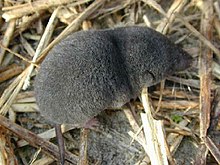| Soricomorpha
[1] Temporal range:
| |
|---|---|

| |
| Southern short-tailed shrew | |
|
Scientific classification
| |
| Domain: | Eukaryota |
| Kingdom: | Animalia |
| Phylum: | Chordata |
| Class: | Mammalia |
| Order: | Lipotyphla |
| Suborder: |
Soricomorpha Gregory 1910 [2] |
| Families | |
Soricomorpha (from Greek "shrew-form") is a formerly used taxon within the class of mammals. In the past it formed a significant group within the former order Insectivora. However, Insectivora was shown to be polyphyletic and various new orders were split off from it, including Afrosoricida ( tenrecs, golden moles, otter shrews), Macroscelidea (elephant shrews), and Erinaceomorpha ( hedgehogs and gymnures), with the four remaining extant and recent families of Soricomorpha shown here then being treated as a separate order. Insectivora was left empty and disbanded. [1]
Subsequently, Soricomorpha itself was shown to be paraphyletic, because Soricidae shared a more recent common ancestor with Erinaceidae than with other soricomorphs. [3] The combination of Soricomorpha and Erinaceidae, referred to as order Eulipotyphla, has been shown to be monophyletic. [4]
Living members of the group range in size from the Etruscan shrew, at about 3.5 cm and 2 grams, to the Cuban solenodon, at about 32 cm and 1 kg.
- Soricomorpha
- Family
Soricidae (shrews)
- Subfamily Crocidurinae: (white-toothed shrews)
- Subfamily Soricinae: (red-toothed shrews)
- Subfamily Myosoricinae: (African white-toothed shrews)
- Family
Talpidae: (
moles and close relatives)
- Subfamily Scalopinae (New World moles and close relatives)
- Subfamily Talpinae (Old World moles and close relatives)
- Subfamily Uropsilinae (Chinese shrew-like moles)
- Family Solenodontidae: solenodons (rare primitive eulipotyphlans of the Caribbean; two extant species)
- Family † Nesophontidae: West Indian shrews (recently extinct eulipotyphlans of the Caribbean)
- Family †
Heterosoricidae
- genus † Atasorex
- genus † Dinosorex
- genus † Domnina
- genus † Gobisorex
- genus † Heterosorex
- genus † Ingentisorex
- genus † Lusorex
- genus † Paradomnina
- genus † Quercysorex
- Family † Nyctitheriidae
- Family
Soricidae (shrews)
References
- ^ a b Hutterer, R. (2005). "Order Soricomorpha". In Wilson, D.E.; Reeder, D.M. (eds.). Mammal Species of the World: A Taxonomic and Geographic Reference (3rd ed.). Johns Hopkins University Press. pp. 220–311. ISBN 978-0-8018-8221-0. OCLC 62265494.
- ^ Gregory, W. K. 1910. The orders of mammals. Bull. Am. Mus. Nat. Hist.27:1–524. https://books.google.com/books?id=z0IZAAAAYAAJ&q=Soricomorpha&pg=PA465
- ^ A. L. Roca; G. K. Bar-Gal; E. Eizirik; K. M. Helgen; R. Maria; M. S. Springer; S. J. O'Brien & W. J. Murphy (2004). "Mesozoic origin for West Indian insectivores". Nature. 429 (6992): 649–651. Bibcode: 2004Natur.429..649R. doi: 10.1038/nature02597. PMID 15190349. S2CID 915633.
- ^ Robin M. D. Beck; Olaf R. P. Bininda-Emonds; Marcel Cardillo; Fu-Guo Robert Liu & Andy Purvis (2006). "A higher level MRP supertree of placental mammals". BMC Evolutionary Biology. 6: 93. doi: 10.1186/1471-2148-6-93. PMC 1654192. PMID 17101039.